Commodities Bull Market Super Cycle is Dead?
Commodities / Resources Investing Aug 21, 2008 - 04:24 PM GMTBy: Gary_Dorsch

 “Those who had been riding the upward wave decide now is the time to get out. Those who thought the rally would last forever, find their illusion destroyed abruptly, and they, also, respond to the newly revealed reality, by selling or trying to sell. And thus the rule, supported by the experience of centuries, - the speculative episode always ends not with a whimper, but with a bang,” so wrote John Kenneth Galbraith in his book “A Short History of Financial Euphoria.”
“Those who had been riding the upward wave decide now is the time to get out. Those who thought the rally would last forever, find their illusion destroyed abruptly, and they, also, respond to the newly revealed reality, by selling or trying to sell. And thus the rule, supported by the experience of centuries, - the speculative episode always ends not with a whimper, but with a bang,” so wrote John Kenneth Galbraith in his book “A Short History of Financial Euphoria.”
Tens of thousands of traders piled into the commodities markets in recent years, attracting nearly $280 billion, bidding-up everything for crude oil to corn, coal to soybeans, and silver to sugar. The speculative boom was most evident in the agricultural and energy sectors, where commodities doubled and tripled from a year ago, and sending official inflation rates to multi-decade highs around the world.
Central bankers in Canada, England, and the United States whetted the speculative appetite of commodity speculators, by slashing their interest rates, and increasing their money supplies. “The truth is that liquidity is the only significant weapon in the central bank's arsenal, but it will not necessarily go where you want it to go, when you need it to go there,” Martin Meyer wrote in his book “The Fed.”
“Once public opinion is convinced that the increase in the quantity of money will continue and never come to an end and consequently, the prices of all commodities will not cease to rise, everybody becomes eager to buy as much as possible and restrict his cash holdings to minimum size. If the credit expansion is not stopped in time, the boom turns to crack-up boom, the flight into real values begins, and the whole monetary system founders,” Ludwig von Mises prophesized in 1949.
Such was the case in the 12-months leading up to July 2nd, when the speculative frenzy in the commodities markets, suddenly began to turn into a bust. Within the span of four-weeks, kingpins of the commodities markets had plunged 20% or more from their July peaks, and dumped into bear market territory. When the parabolic booms were followed by wicked corrections, the eternal skeptics of the “Commodity Super Cycle” began to wake-up from seven-years of hibernation.
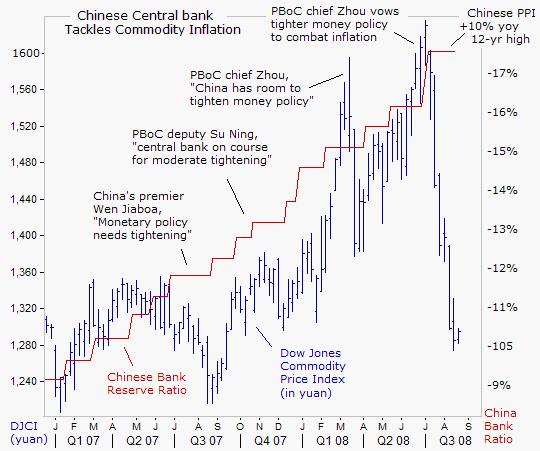
While the Fed, the British, and Canadian central bankers were stoking the mania in the commodities markets, a coalition of six influential central banks, from Brazil, China, Europe, India, Korea, and Russia, were working collectively in the opposite direction. The Group-of-Six, led by ECB chief Jean Claude Trichet, tightened their monetary policies, in the hope of derailing the powerful “Commodity Super Cycle,” which was wrecking havoc across the global economic landscape.
“Global monetary policy must tackle inflation, even if it is driven by rising food and energy prices,” said China's central bank chief Zhou Xiaochuan, after meeting European and other east Asian central bankers in Rome on June 27th. “We are trying to use some monetary instruments to tighten monetary supply. But which instruments to use, it is not convenient to say,” he said.
Over the past 18-months, the People's Bank of China (PBoC) soaked up vast amounts of yuan by repeatedly increasing banks' reserve requirement ratio to a record 17.5%, selling huge blocks of government securities, and letting the Chinese yuan strengthen 12% against the dollar. Finally, the PBOC's last tightening move appeared to hit the bulls-eye, and gotten ahead of the inflation curve. The Dow Jones Commodity Index plunged 20% versus the yuan, in six weeks.
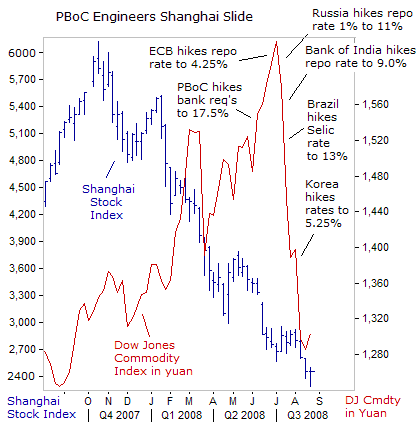
However, the PBoC's tightening campaign produced some brutal side-effects, most notably, the bursting of the Shanghai red-chip bubble, which had soared five-fold in less than two-years, to a record 6,150 in October 2007. Chinese investors had opened 46-million new trading accounts in 2007, nine times the amount of the previous year, and poured $2.2 trillion of their savings into equities. The frenzied demand pushed up valuations of China's stocks to the highest in the world.
On October 24, 2007, Billionaire Warren Buffett warned investors to be cautious about Chinese stocks. “We never buy stocks when we see prices soaring. We buy stocks because we're confident of the company's growth. People should be cautious when they see prices rising,” he said. Since then, Shanghai's main stock index has tumbled 62%, amid worries that China will feel the pinch of a synchronized economic recession in Europe, Japan, and the US, its three biggest overseas customers.
A year-ago, few investors could have envisioned that Beijing would engineer the bursting of the Shanghai red-chip bubble ahead of the Olympics. But now traders expect Chinese corporate profit growth to grind to a halt by next year, after slowing to +20% in the first half of this year, because of a slowing global economy, and squeezed by sharply higher raw-material and fuel costs.
Shift in Market Psychology, Brazil Tackles Inflation
Psychology in the commodities markets has swung from the “fear of inflation” and the mad scramble for natural resources, to the theme of “Demand Destruction,” or worries that a global economic downturn will weaken demand for commodities. China consumes more commodities than any other country, except for crude oil, so the prospect of a sharp slowdown in the juggernaut Chinese economy has knocked the commodities markets off their bullish stride. “When the facts change, I change my mind. What do you do, sir?” asked John Maynard Keynes.
The Bank of Brazil (BoB) has earned the respect of investors worldwide, for its tough stance in the battle against inflation this year. Brazil's central bank hiked its benchmark Selic lending rate on July 23rd by 75-basis points to 13%, and has lifted borrowing rates by 175-basis points in four months, to tackle commodity inflation. Brazil's consumer price index rose above 6% in July, triggering an immediate rate hike by the central bank. Within days, the year-over-year change in the Dow Jones Commodity Index went negative when measured in Brazilian reals.
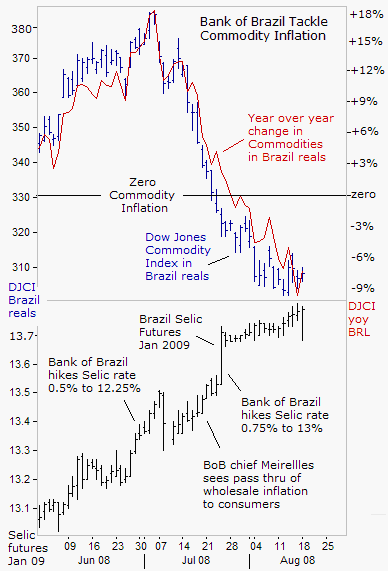
“There are indications that monetary policy has started to affect inflation expectations,” said BoB chief Henrique Meirelles on August 18th. “The recent drop in current and expected inflation shows not only that it is feasible, but also reinforces the BoB's commitment to bring inflation back to the center of the 4.5% target in 2009,” he added. Still, futures trades in Sao Paulo expect another 50-basis point BoB rate hike to 13.50%, to drive another nail into the coffin of inflation expectations.
Much like China's central bankers, Meirelles has been willing to pay the price of a sharp slide in Brazil's stock market to tackle inflation. The international respect for the Bank of Brazil stands in sharp contrast to the disgrace that was heaped upon the Bank of England last week, which for all practical purposes abandoned its long discarded 2% inflation target. Global flight from the British pound quickly ensued, knocking its trade-weighted value to a 12-year low, since foreign investors don't trust the Bank of England to keep inflation pressures under control.
US Dollar Looks a Little less Ugly
The debate over whether the “Commodity Super Cycle” is dead or alive, also revolves on whether the US-dollar has hit rock bottom against the Euro and other foreign currencies. A stronger US-dollar creates a virtuous circle of knocking commodity markets lower, easing inflation pressures, and gives central banks more wiggle room to lower interest rate and expand the money supply.
The dollar staged its biggest gain against the Euro in 7 ½-years on August 8th, and hit a 5-month high versus the Australian dollar and Japanese yen, amid evidence that the US economy's slide into recession is spreading to the rest of the world. This view was confirmed when Tokyo reported a -0.6% contraction in Japan's economy in the second quarter, and the Euro-zone shrank by -0.2%, its first decline since 1995. Previously, FX traders had figured the Euro-zone could avoid a recession.
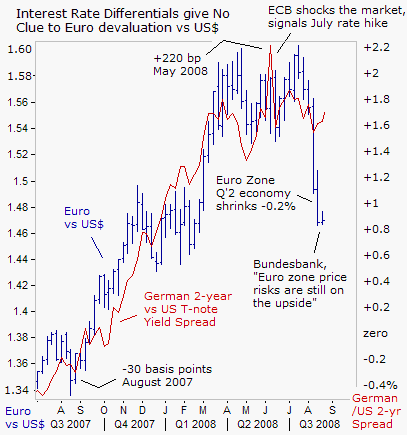
Trading in foreign currencies is akin to judging a reverse beauty contest, and suddenly, the US-dollar's was looking a little less ugly than its peers. However, what caught many currency traders off-guard was the Euro's sudden plunge below the psychological $1.50 level, even though the interest rate differentials between the world's top-two traded currencies hardly budged.
Interest rate differentials between the German and US 2-year government notes were a key driver of the Euro /dollar exchange rate over the past few years. Earlier today, the German 2-year schatz was yielding +164-basis points more than the US 2-year note, a spread that was high enough that support the Euro above $1.5300 for most of this year. So why the sudden shift in market psychology behind the Euro's devaluation, and what's driving the Euro these days?
The answers to this perplexing question were revealed in the August 15th edition of the Global Money Trends newsletter. But although the Euro–zone economy is slipping into a mild recession, that does not mean that the ECB is about to lower its repo rate anytime this year. “The economic dry spell should not mislead us into talking up the danger of recession,” said Bundesbank chief Axel Weber on August 14th. “The German and the European economies remain in a robust state. Discussion about the end of the upturn is misplaced,” he warned.
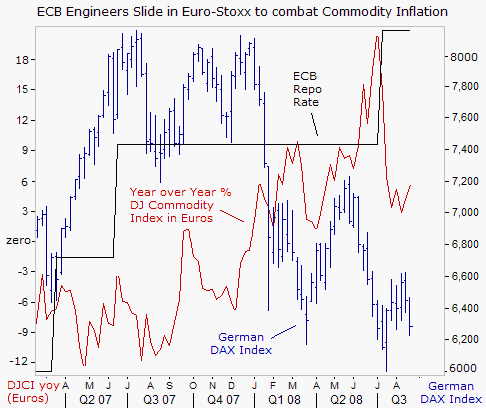
On August 18th, the Bundesbank (BBK) warned that a slow-down in the Euro-zone economy does not automatically guarantee a sustained decline in core inflation. “The fact that weaker growth rates are expected for the economy in the near future does not mean that enough of a countervailing effect for price stability is taking shape and automatically offsetting the pressure on prices,” it added. The DJ Commodity Index is still 7% higher in euro terms than a year ago, which is too high for the BBK.
Indeed, while the ECB hawks and the Group-of-Six dealt a punishing blow to commodity speculators in July, the war against the “Commodity Super Cycle,” has several tough battles that lie ahead with commodity speculators. History shows that commodity markets can turn on a dime, and without notice.
Today's focus on “demand destruction” can switch to the super-easy money policies of the Bank of Japan and the Fed, with lending rates at negative interest rates, or perhaps, worse than expected grain crops, or saber rattling in the Middle East or in the Kremlin. On August 20th, the Russia warned it will respond with more than just diplomatic protests to the US-Poland missile shield deal, and says the US missile shield plan is part of an “extremely dangerous bundle of military projects.”
In the game of commodity and FX trading, one must be quick on the trigger, and have the skills of a psycho-analyst, in order to anticipate and profit from the next major market move. “You must never delude yourself into thinking that you're investing, when you're speculating,” said Benjamin Graham.
G-6 Topples Gold market, but Financial Crisis in Brewing
The Group-of-Six central banks, which oversee 40% of the world's economy decided to slow their fast growing economies, in order to keep commodity prices in check. Their rapid fire tightening moves over the past two months, contributed to the crash in the gold market since July 15th. India, the biggest consumer of gold, imported 30-tons in July, or 56% less than a year ago, and Saudi Arabia and the UAE bought less in the second quarter, showing resistance to gold prices above $900 /oz.
Gold dealers detected a binge of buying from India, after prices fell below $800 an ounce, helping to stabilize the market after a brutal 25% correction from its all-time highs of $1,035 /oz. However, the gold market could encounter resistance until Sept 27th, the end of the fiscal year for 15-European central banks to sell as much as 500-tons of gold. So far, the 15-signatories have sold only 320-tons.
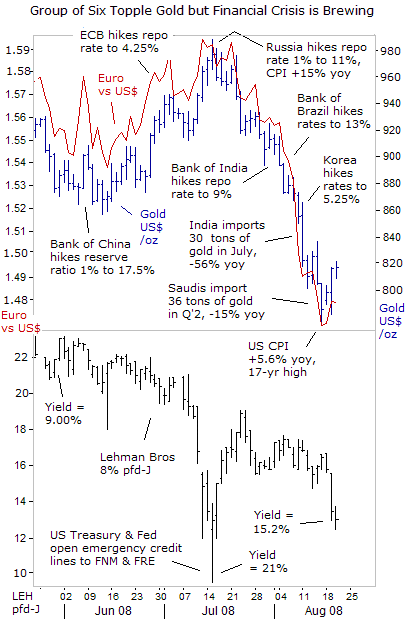
Gold's role as a safe haven in times of financial crisis might come into play again, if the Fed is forced into another round of rate cuts, to fend off a systematic meltdown in the US credit markets. On August 18th, Kenneth Rogoff, former chief economist at the IMF warned, “The worst is yet to come. The financial sector needs to shrink. I don't think having a couple of medium-sized and small banks going under are going to do the job. Like any shrinking industries, we are going to see the exit of some major players among the big investment banks,” he warned.
Shares of Lehman Brothers LEH.n plunged to $13 per share on August 19th amid growing fears the company will be forced to sell assets or take other capital-raising measures to offset mortgage-related losses in the third quarter of as much as $4 billion. In a major sign of distress, LEH's preferred J-shares has lost nearly 40% over the past two months, lifting its yield to 15.2%, and deep into junk status territory. And where there is smoke, there usually is fire.
Shares of mortgage finance companies Fannie Mae and Freddie Mac fell to as low as $4.74 and $2.84 respectively on August 20th, and investors are convinced that the stocks will drop to one US-cent, in a US government bailout. Fannie's stock is down 87% so far this year, while Freddie has lost 90% of its value, and their combined market capitalization is less than $8 billion.
“A sound banker, alas, is not one who foresees danger and avoids it, but one who, when he is ruined, is ruined in a conventional way along with his fellows, so that no one can really blame him,” wrote John Maynard Keynes in 1931.
Saudis Topple Oil market, US Election Politics
“In most bull markets, there comes a time when the public controls fluctuations and the efforts of the largest operators are insufficient to check the rising tide,” said Charles Dow in 1901. But over the past 3-months, the OPEC cartel boosted its oil output by 1.2 million barrels per day to 30.2 million bpd, and appears to have gotten the upper hand over the combustible “black gold” market.
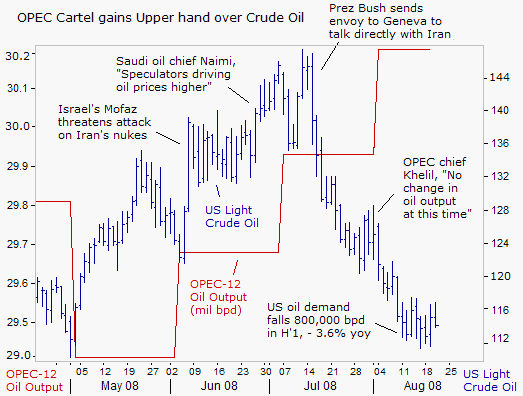
“The price of oil has fallen $20 in recent days, which backs our position that this is not a problem of volume, it's not a problem of production but rather it's linked to speculation,” Venezuelan oil chief Rafael Ramirez said on July 29th. “Obviously, when the price of crude oil oscillates $20 up or down in such a short time, it doesn't have anything to do with production,” he observed.
Iran's oil chief Muhammad Ali Khatibi says the global oil market is now oversupplied by roughly one-million barrels per day, but expects winter demand in the fourth quarter, to soak up the excess supply. US President George Bush deflated a $15 per barrel, Iranian “war premium” in the oil market, on July 16th, when he sent a special envoy to Geneva to speak with Tehran's nuclear negotiator Saeed Jalili, marking a major shift in US negotiating policy with the “Axis of Evil.”

The direction of gold prices and inflation expectations also hinge on the direction of world oil prices. It's doubtful that the ECB hawks and the Group-of-Six central banks would have been so successful in knocking gold and oil prices lower without the help of Saudi king Abdullah, the central banker of oil. Iran and Venezuela would like to see the Saudis cut their oil output at the upcoming OPEC meeting on Sept 9th to stabilize the oil market, and prevent prices from moving lower.
However, the Saudi kingdom might be looking at the US political calendar, and would feel more comfortable with a John McCain presidency, thus Riyadh might be inclined to leave its oil output unchanged awhile longer. Already, the 25% drop in crude oil prices from five-weeks ago is paying dividends for Riyadh. In a sharp turnaround, Republican John McCain has opened a 5-point lead on Democrat Barack Obama in the US presidential race, wiping out Obama's solid 7-point advantage in July, and taking his first lead in the monthly Reuters/Zogby poll.
So is the “Commodity Super Cycle” dead or alive? Is now the time to buy badly battered commodities? The answers to these tough questions will be published in the August 23rd edition of Global Money Trends.
By Gary Dorsch,
Editor, Global Money Trends newsletter
http://www.sirchartsalot.com
GMT filters important news and information into (1) bullet-point, easy to understand analysis, (2) featuring "Inter-Market Technical Analysis" that visually displays the dynamic inter-relationships between foreign currencies, commodities, interest rates and the stock markets from a dozen key countries around the world. Also included are (3) charts of key economic statistics of foreign countries that move markets.
Subscribers can also listen to bi-weekly Audio Broadcasts, with the latest news on global markets, and view our updated model portfolio for Q'1, 2008. To order a subscription to Global Money Trends, click on the hyperlink below, http://www.sirchartsalot.com/newsletters.php or call toll free to order, Sunday thru Thursday, 8 am to 9 pm EST, and on Friday 8 am to 5 pm, at 866-553-1007. Outside the call 561-367-1007.
Mr Dorsch worked on the trading floor of the Chicago Mercantile Exchange for nine years as the chief Financial Futures Analyst for three clearing firms, Oppenheimer Rouse Futures Inc, GH Miller and Company, and a commodity fund at the LNS Financial Group.
As a transactional broker for Charles Schwab's Global Investment Services department, Mr Dorsch handled thousands of customer trades in 45 stock exchanges around the world, including Australia, Canada, Japan, Hong Kong, the Euro zone, London, Toronto, South Africa, Mexico, and New Zealand, and Canadian oil trusts, ADR's and Exchange Traded Funds.
He wrote a weekly newsletter from 2000 thru September 2005 called, "Foreign Currency Trends" for Charles Schwab's Global Investment department, featuring inter-market technical analysis, to understand the dynamic inter-relationships between the foreign exchange, global bond and stock markets, and key industrial commodities.
Copyright © 2005-2008 SirChartsAlot, Inc. All rights reserved.
Disclaimer: SirChartsAlot.com's analysis and insights are based upon data gathered by it from various sources believed to be reliable, complete and accurate. However, no guarantee is made by SirChartsAlot.com as to the reliability, completeness and accuracy of the data so analyzed. SirChartsAlot.com is in the business of gathering information, analyzing it and disseminating the analysis for informational and educational purposes only. SirChartsAlot.com attempts to analyze trends, not make recommendations. All statements and expressions are the opinion of SirChartsAlot.com and are not meant to be investment advice or solicitation or recommendation to establish market positions. Our opinions are subject to change without notice. SirChartsAlot.com strongly advises readers to conduct thorough research relevant to decisions and verify facts from various independent sources.
Gary Dorsch Archive |
© 2005-2022 http://www.MarketOracle.co.uk - The Market Oracle is a FREE Daily Financial Markets Analysis & Forecasting online publication.


